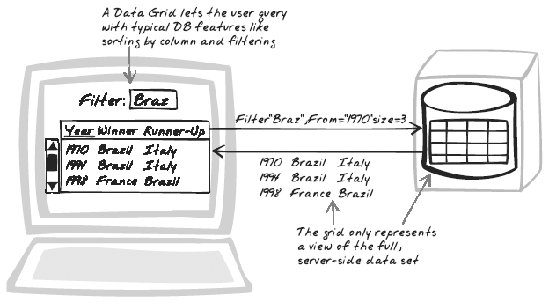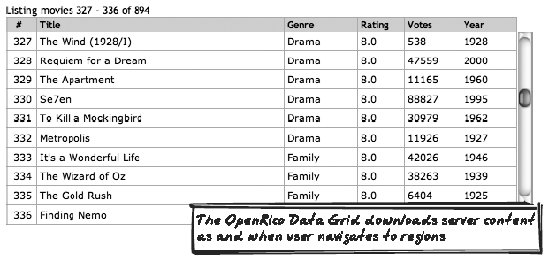Section 14.4. Data Grid
14.4. Data GridDatabase, Query, Report, Summary, Table Figure 14-11. Data Grid 14.4.1. Goal StoryReta is doing a little data mining on this season's sales figures. She's scrolling through a table showing a row for every transaction. Noticing that higher sales figures tend to come in the morning, she sorts the table by sales figure. There's too much data there, so she filters out any transactions below $1,000, then groups the transactions by time of day. 14.4.2. ProblemHow can you help users explore data? 14.4.3. Forces
14.4.4. SolutionReport on some data in a rich table and support common querying functions. A Data Grid has the familiar database client interface: a table with a row for each result and a column for each property. Think of it as a traditional table on steroids. Typical database client functionality is as follows (and it's feasible to achieve each of these in an Ajax interface):
With the magic of Web Remoting (Chapter 6), the grid can become a Virtual Workspace (Chapter 15, giving the illusion of holding a massive set of data. In reality, the data lives on the server, and each User Action leads to a new server call. Most queries lead to a structured response, such as an XML Message or a JSON Message, containing a list of results for JavaScript rendering, or alternatively an HTML Message with the specific view the user will see. The semantic style has the advantage of encouraging performance optimizations such as Predictive Fetch, which are essential if you want the grid to feel responsive. 14.4.5. Decisions14.4.5.1. Will the Grid be Read-Only or Mutable?Editing a table directly can be more productive for experts, though it's often more difficult for novices than editing a single record in a form, since a form usually has a more verbose interface. Grid mutability adds a couple of extra considerations:
14.4.6. Real-World Examples14.4.6.1. OpenRico Data Grid exampleThe OpenRico Data Grid example (http://openrico.org/rico/livegrid.page) shows a list of movies, each with several fields: ranking, title, genre, rating, votes, and year (Figure 14-12). You can scroll down the list and sort each column header. You can also bookmark a position in the table (an example of Unique URLs). Figure 14-12. OpenRico Grid Movie demo 14.4.6.2. NumSumNumSum (http://NumSum.com) is a spreadsheet, and spreadsheets are a special, powerful case of Data Grids; they are to Data Grids what Data Grids are to conventional tables (Figure 14-13). Figure 14-13. NumSum 14.4.6.3. OddpostOddpost (http://oddpost.com/learnmore) is an Ajax mail client with a very similar look and feel to desktop clients like Outlook. The subject headers table is a form of Query-Report Table. As with the OpenRico example, you can scroll through the table and sort by column. 14.4.6.4. Delta VacationsDelta Vacations (http://www.deltavacations.com/destination.aspx?code=MONTEGOBAY) appears as a Live Search example, but it also serves as an example of filtering. Initially, all hotels in a destination are shown, and typing a search term retains only matching results. 14.4.7. Code Example: OpenRico Data GridThe OpenRico Data Grid example (http://openrico.org/rico/livegrid.page) uses OpenRico's LiveGrid API. In the initial HTML, there are two tables: one for the column headers and one for the data. Note that the data table declares all the visible table rows, initialized with the values in the first few rows. This is an example of a Virtual Workspace (Chapter 15)the rows will always stay fixed, but their data will change as scrolling occurs: <table cellspacing="0" cellpadding= "0" style="width:560px"> <tr> <th style="width:30px;text-align:center"> #</th> <th style="width:280px">Title</th> <th style="width:80px">Genre</th> <th style="width:50px">Rating</th> <th style="width:60px">Votes</th> <th style="width:60px">Year</th> </tr> </table> <table cellspacing="0" cellpadding="0" style="width:560px; border-left:1px solid #ababab"> <tr> <td style="width:30px;text-align:center">1</td> <td style="width:280px"> Bend of the River</td> <td style="width:80px">Western</td> <td style="width:50px">7.3</td> <td style="width:60px">664</td> <td style="width:60px">1952</td> </tr> ... </table> The grid is initialized on page load, with some configurable options passed in: var opts = { prefetchBuffer: true, onscroll: updateHeader }; onloads.push( function( ) { tu = new Rico.LiveGrid( 'data_grid', 10, 950, 'getMovieTableContent.do', opts )} ); The grid will then handle all user events. Notice the getMovieTableContent.do argument in its construction. That's the URL that will feed the grid with further data. It must be capable of accepting in certain parameters, such as initial position and number of rows to retain. For example, to load the page initially and scroll all the way to the end (rows 940 and on), the XMLHttpRequest Call (Chapter 6) goes to the following URL: getMovieTableContent.do?id=data_grid&page_size=10&offset=940&_=. What's retrieved are 10 movies starting at 941 in an XHTML format, as shown in the following example. The grid component then updates itself with those rows. <?xml version="1.0" encoding="ISO-8859-1"?> <ajax-response> <response type="object" id='data_grid_updater'> <rows update_ui='null' > <tr> <td>941</td> <td convert_spaces="true"> El Dorado</td> <td> <span style="font-weight:bold"> Western </span> </td> <td>7.4</td> <td>2421</td> <td>1966</td> </tr> ... </rows> </response> </ajax-response> 14.4.8. Related Patterns14.4.8.1. Virtual WorkspaceAs explained earlier in the "Solution," Data Grids are usually Virtual Workspaces (Chapter 15). 14.4.8.2. Browser-Side CacheTo improve performance, retain data in a Browser-Side Cache (Chapter 13). 14.4.8.3. Predictive FetchTo improve performance, consider Predictive Fetches (Chapter 13) that preload nearby results and aggregation functions. 14.4.8.4. Progress IndicatorLonger updates should be accompanied by a Progress Indicator (see earlier). 14.4.9. MetaphorA Data Grid is the natural sequel to the traditional HTML table. 14.4.10. AcknowledgmentsChristian Romney (http://www.xml-blog.com/) suggested the idea of a sort-and-filter pattern from which this pattern evolved, and also pointed out the Delta Vacations example. |